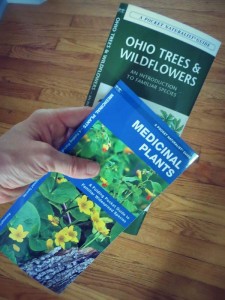Nature’s summertime table is full of delicious native foods. Most wild edibles are easy to find and identify. Foraging is a fun family activity that can help children form a meaningful connection with nature. Even kids that usually turn up their noses at healthy fruits and vegetables love to hunt and help prepare wild foods!
Summer foods to forage
Purslane surrounds sidewalks and pops up in parking lots. It has a reddish colored stem and several small, succulent, oval-shaped leaves. The entire plant is edible. Eat it raw or steamed.
Pawpaws are a sweet, creamy and delicious native fruit. Pawpaw trees are short with big leaves. Trees are prevalent in the southern Ohio woodlands. Light green fruit is ready to pick in late summer.
Elderberries were historically used to make wine and preserves. The tiny, deep purple berries are ready to harvest in late summer.
Blackberry bushes are tall and thorny with white flowers. Berry juice stains clothes and fingers. Wear gloves when handling. Berries begin to ripen mid-summer and continue through late summer.
Dandelion is probably the easiest wild edible to find and identify. All parts of the plant are edible but the tangy greens are especially nutritious. Eat leaves raw in salad or cook lightly.
Chickweed leaves are mild flavored. They make a great addition to seasonal vegetable dishes. Though the plant flourishes all summer long, chickweed is easiest to identify by its tiny white flowers which bloom in mid-summer.
Sumac trees produce dark red, antioxidant-rich berries in late summer. The tart berries can be made into tea or dried and used as seasoning. Smooth and staghorn sumac are safe to enjoy.
Wood sorrel is a garden weed. When I learned it was edible I quit weeding it out and started harvesting it right along with my lettuce. Wood sorrel leaves look like clovers. The plant produces very small yellow flowers which are also edible.
Plantain leaves are very bitter; boil 3-5 minutes to relieve some of the bite. The plant was historically used to treat external wounds and burns. It was taken internally to treat digestive disorders. The entire plant is edible.
Wild grapes, like riverbank and fox grapes, are common in southern Ohio. I find grape vines overtaking small trees and shrubs along the creek bank. Wild grapes have large, heart-shaped leaves that are also edible. Grapes ripen in late summer but taste better after frost.
Tiger lily is commonly referred to as ditch lily because it grows wild along Ohio roadsides. The entire plant: flowers, buds, stalks and root tubers, is edible. Lily tubers are often featured in Asian cuisine.
Safe foraging
- Most state forests allow foraging, but many state parks and nature preserves do not. Some species of native plants are protected. Check park rules and regulations before hunting and gathering.
- Make sure to get permission to forage on private property. Foraging without permission can result in unwanted confrontations and even legal problems. Plus, asking for permission to forage is a matter of courtesy.
- Make a positive identification of the plant prior to picking. Many edible plants, like sumac, have poisonous relatives and lookalikes. Identify multiple traits that match edible plant characteristics to confirm the plant in question. Edible plant identification guides describe each plant’s fruit or flower, leaf pattern and stem. A good guide is a forager’s best friend.
- Do not gather wild edibles from areas that have been treated with pesticides or herbicides.
- Use common sense when collecting. If the plant is half eaten by wildlife, or parts of it are covered in bird droppings, do not harvest it.
- When in doubt, don’t pick.
Identification guides

Any of these guides are useful for identifying edible plants:
Backyard Foraging: 65 Familiar Plants You Didn’t Know You Could Eat by Ellen Zachos, is great for beginners and casual foragers. It only contains common plants; those you are most likely to encounter. The book’s full color pictures make identification easy.
Petersen Field Guides puts out a much more extensive book that is geared to our region, A Field Guide to Edible Wild Plants: Eastern and central North America. This guide gives awesome details, but overwhelming for hobby foragers.
Pocket Naturalist Guides by Waterford Press give quick info about common plants at a glance. They are lightweight and waterproof. I have a half dozen ranging in topics from edible and medicinal plants to weather patterns.













